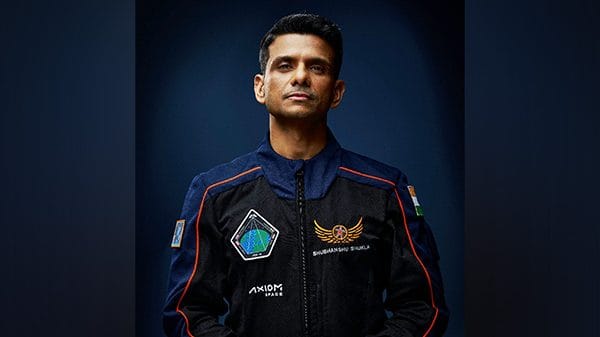New Delhi: “Namaskar mere deshwasiyon (Greetings, my countrymen). After 41 years, we are back in space — and what a magnificent journey it has been,” a beaming Shubhanshu Shukla said as he became the second Indian in space after Rakesh Sharma, who was part of a Soviet-Indian space mission in 1984.
Astronaut Shubhanshu Shukla, speaking from space, shared that the Axiom Mission 4 crew was currently circling Earth at a 7.5 kilometre per second speed. “The Tricolour rests on my shoulder—a symbol that I carry each one of you with me,” Shukla, who has had an illustrious career in the Indian Air Force before training as an astronaut, said. “This is the beginning of the Indian human space flight programme.”
The Axiom Mission 4, the fourth private astronaut mission to the International Space Station (ISS), lifted off at 12.01 pm IST Wednesday from Launch Complex 39A at the Kennedy Space Centre of the National Aeronautics and Space Administration (NASA) in Florida. NASA, Axiom Space, Indian Space Research Organisation (ISRO), and SpaceX have partnered to execute the commercial mission.
As part of Axiom-4, a four-member multinational crew is flying to the space station, ISS, in a new SpaceX Dragon capsule C213, which a Falcon 9 Block 5 rocket launched into space.
With this mission, Indian astronaut Shubhanshu Shukla will also become the first ISRO astronaut to travel to the ISS. Shukla is serving as the mission pilot alongside commander Peggy Whitson, a former NASA astronaut and current director of human spaceflight at Axiom Space, as well as the one leading the mission. The Axiom-4 crew also includes mission specialists Sławosz Uznański-Wiśniewski (Poland) and Tibor Kapu (Hungary).
According to NASA, the commercial astronaut flight will dock Thursday at the ISS at approximately 4.30 pm IST. Once aboard the orbiting laboratory (ISS), the Axiom-4 crew plans to spend up to two weeks there, conducting nearly 60 scientific research and commercial activities as well as outreach initiatives.
Some key projects under ISRO’s purview include microalgae cultivation, muscle atrophy and treatment, and crop seed studies on the ISS.
The Axiom-4 also paves the way for ISRO’s upcoming Gaganyaan Mission, which aims to send a three-member crew on a three-day journey to the Low Earth Orbit, 400 km from the Earth, before safely returning the crew to Earth.
The Axiom-4 crew will conclude their mission with a splash down in the Pacific Ocean near California.
The mission, originally planned to take off 29 May, faced multiple delays due to various technical and safety concerns. First postponed to 8 June due to an issue with the electrical harness in the crew’s Dragon module, the launch was rescheduled again due to delays in the readiness of SpaceX’s Falcon 9 rocket. On 10 June, another setback occurred after ISRO recommended in-situ repairs or component replacement, followed by a low-temperature leak test. A liquid oxygen leak, a pressure leak in the Zvezda, and ongoing safety checks caused further delays before the final launch on 25 June 2025, with the crew safely reaching the ISS.
(Edited by Madhurita Goswami)






